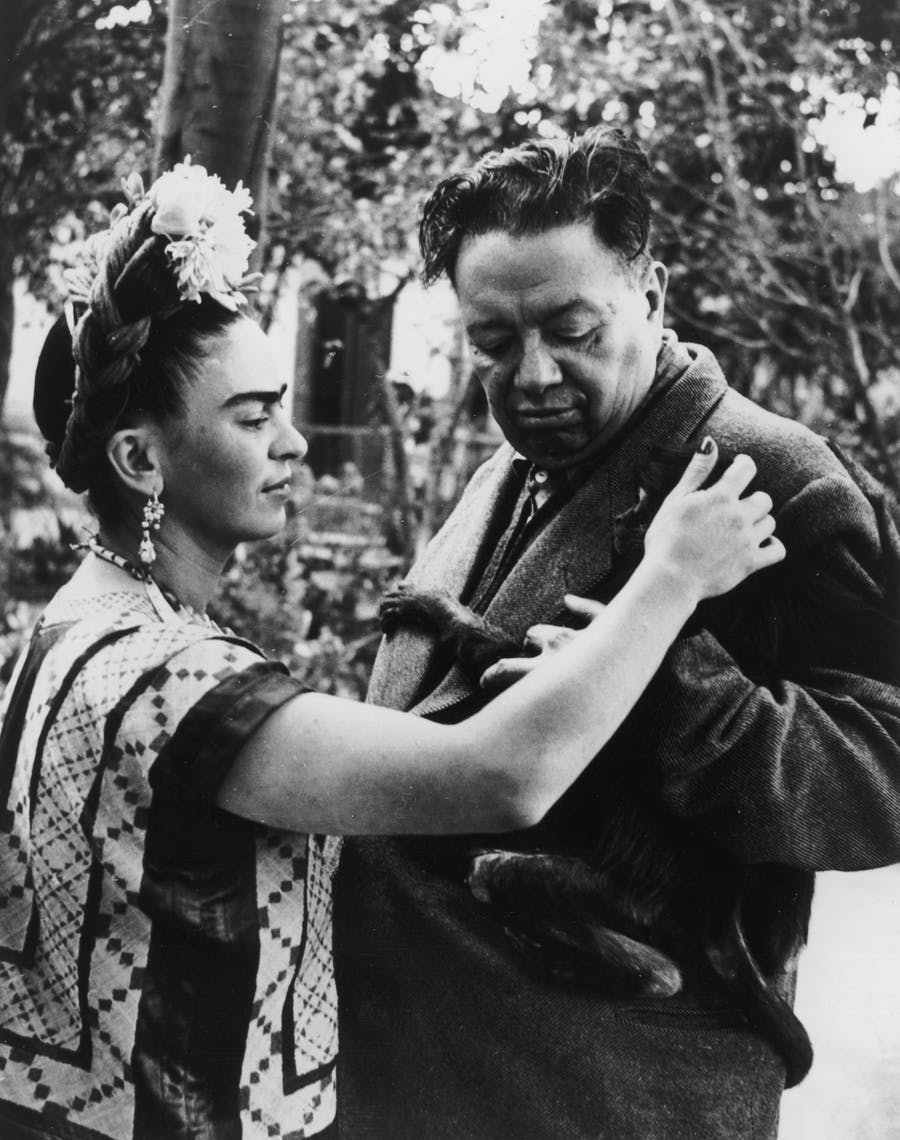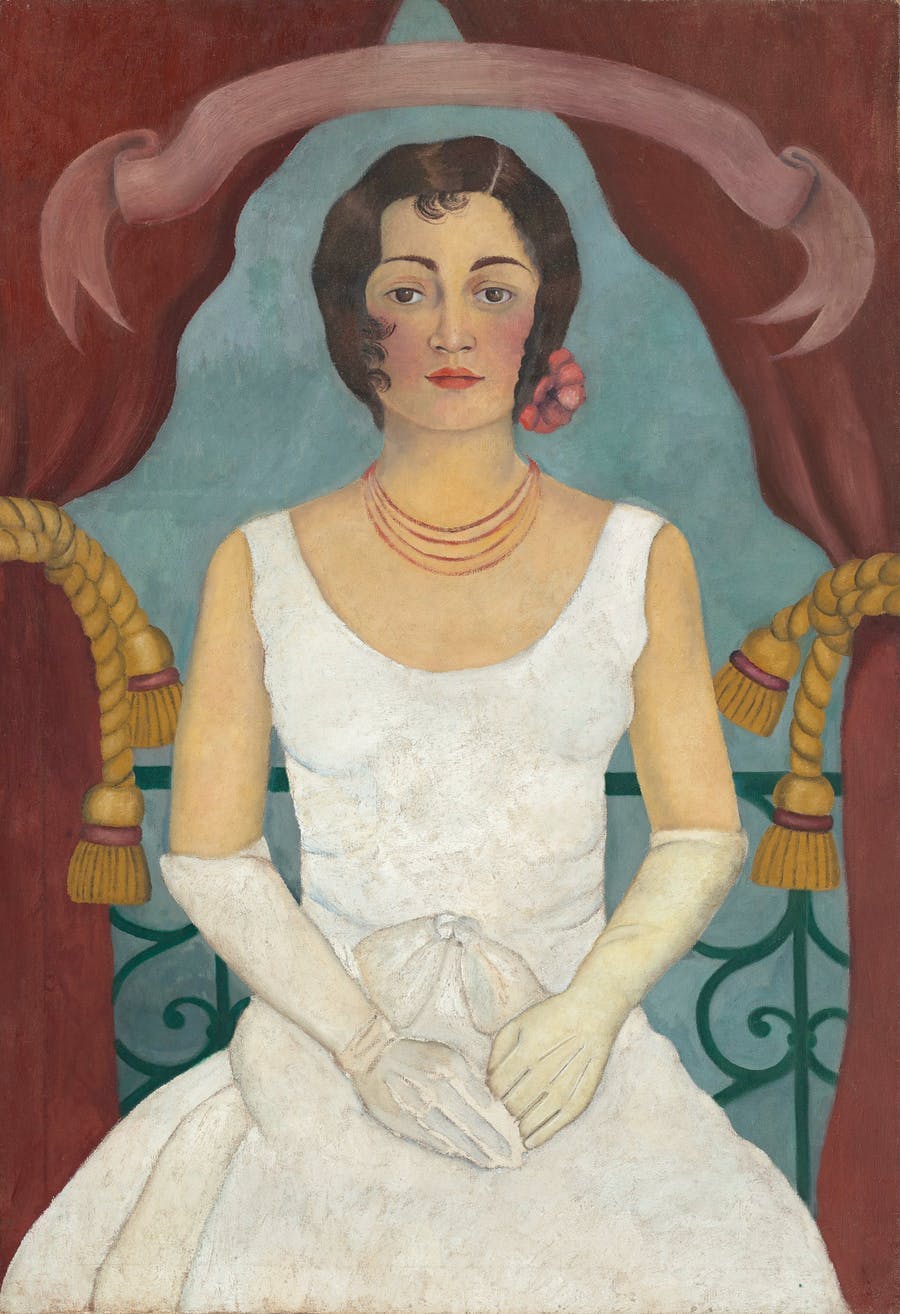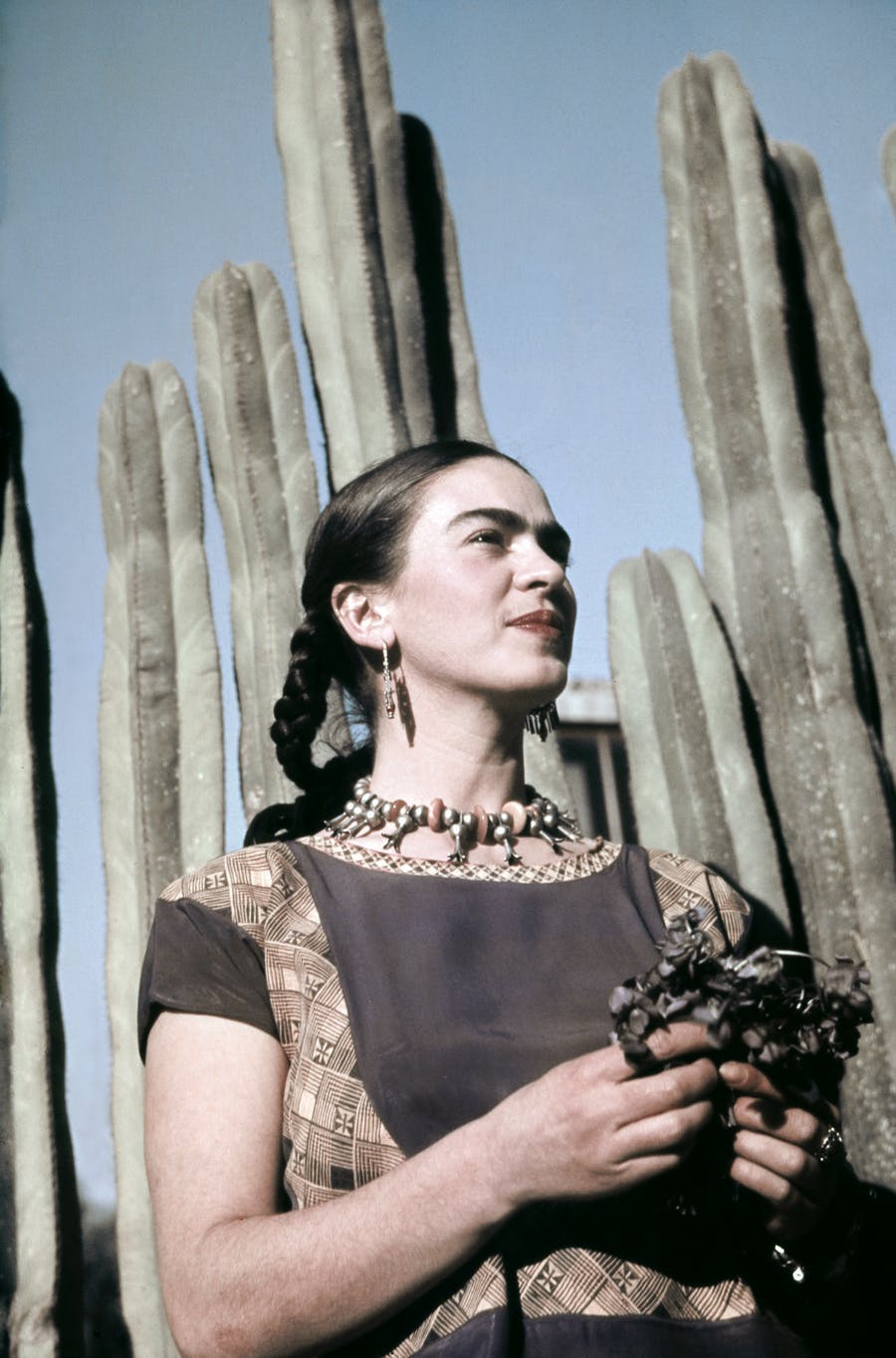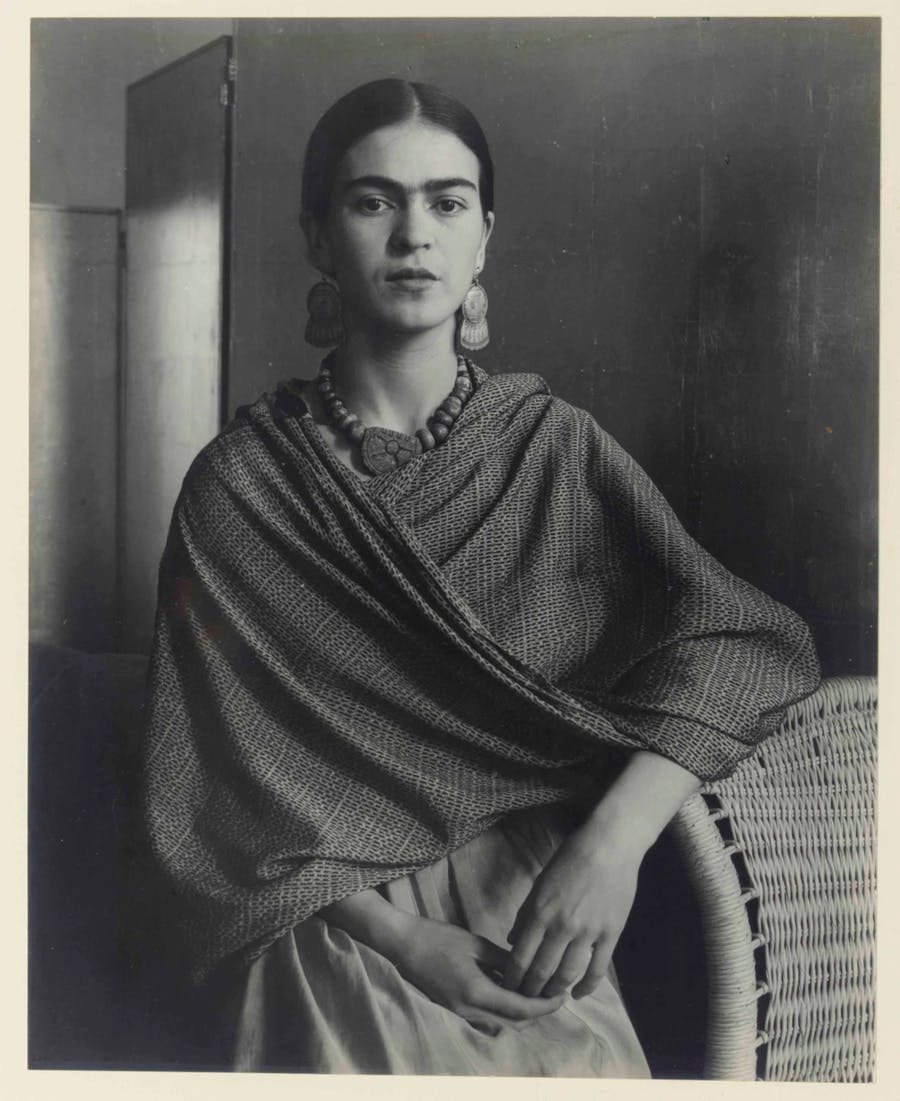Frida Kahlo: Colorful Portraitist and Social Commentator
Through strong colors, expressive motifs and personal and political messages, Frida Kahlo contributed to the formation of Mexico's post-revolutionary identity.
The young years
Frida Kahlo was born on July 6, 1907 in Coyoacan outside of Mexico City. Her father was loving but drifted in and out of depression and was diagnosed early on with epilepsy. Her mother, Mathilde Calderon y Gonzalez, ruled the home with an iron fist. She was a strong female figure in whose footsteps Frida soon followed.
In Mexico, a woman's passivity and submissiveness were the norm – a template that did not particularly suit Kahlo. She took after her mother and grew up to be an independent and driven young woman. At the age of 18, she entered medical school, a dream that came to a painful end in 1925 when she was seriously injured in a bus accident. With a broken spine and ribs, eleven fractures on her right leg and a broken foot, she lay in bed for a long time. Her body was pierced by an iron pipe, which further hampered her recovery and later affected her reproductive ability.
Due to the immense boredom that the hospital stay generated, she took up painting. She had to make do with the motifs that were immediately available, such as self-portraits and depictions of friends and family.
Diego Rivera

During her convalescence, she came in contact with the artist Diego Rivera. This relationship, initially professional, soon developed into a relationship and the couple married in 1929. Throughout the years, Kahlo's art has involuntarily become closely linked to her marriage to Rivera.
Rivera was an esteemed and well-to-do artist in both their home country and in the USA, where they moved to in 1930. The view of women in the USA was, like in her home country, conservative and Kahlo never particularly enjoyed herself there.
Style profile

Kahlo was involved in Mexicanidad, an aesthetic movement that paid homage to native Mexican culture. She clearly distanced herself from American and European politics and culture, and her artistic work became important in the building of Mexico's post-revolutionary identity. Her art has been described as naive or primitive due to her strong color choices and clear contours. Her painting is clearly influenced by folk art and has often been interpreted as strongly nationalistic.
Related: Diego Rivera: 7 Facts to Know
Her art depicts political anti-capitalist positions. The design language is eclectic and contains elements of several different styles. Popular culture and avant-garde modernism influenced Kahlo’s imagery, and although she liked to distance herself from Europe, she could not help but be inspired by Italian Renaissance masters, such as Sandro Botticelli and Bronzino. There is an elegance in Kahlo's painting which is evocative of the Pre-Raphaelites, while her elaborate physical depictions are reminiscent of Amedeo Modigliani.
During the 1930s, Kahlo met the French writer and Surrealist André Breton. They soon became good friends and Breton showed great interest in Kahlo's art. In 1938, he made her first exhibition in New York possible. Breton believed that Kahlo's art, filled with imagination and symbolism, was of a clearly Surrealist nature, but Kahlo herself did not agree. She insisted that she never painted her dreams, only her own reality.
Self-portrait on the Borderline between Mexico and the United States

Since the traffic accident from her twenties, Kahlo herself had been her most frequent motif and it is for her self-portrait that many people know about Frida Kahlo today: most people think of her as ‘she with the eyebrows’.
During her time in the United States, she painted Self-portrait on the Borderline between Mexico and the United States (1932). The painting depicts Kahlo wearing a pink dress standing on the border between the two countries. She stands with her back to the barren, industrial landscape that symbolizes the United States, where tombstone-like skyscrapers tower over massive factory buildings made of brick. With her head turned to the right, she stands facing her homeland. There, nature flaunts, and the ground at her feet is sprinkled with religious figurines and skulls. In the background we see ancient temples – a connection to the religious origins of Mexico.
Related: 10 Artist Couples You Should Know
The painting is a representation of her ambivalent attitude to the neighboring country in the north. It also underlines the obvious contrast between what she saw as the industrial, capitalist and inhumane United States and the fertile, traditional Mexico. The work is an example of the nationalist in Kahlo's painting and how she was strongly influenced by the Mexicanidad movement's reluctance to the Western.
The Two Fridas
The oil painting The Two Fridas from 1939 addresses questions around the inherited role of a woman. On the left, Kahlo is wearing a Victorian outfit that refers to her European origins. The other Kahlo, placed on the right of the picture, is wearing a traditional Tehuan dress. The Tehu costume was worn by women in matriarchal societies in ancient Mexico. The Tehuan is a recurring motif in Kahlo's art. That she chooses to portray herself as a Tehuan woman shows her unwillingness to adapt to the traditional female norm. These mythical ancient Mexican women represented a freedom and independence with which Kahlo strongly identified.
Related: The 15 Most Expensive Female Artists
Once again, Kahlo plays with contrasts in the painting. There is a clear difference between the Victorian, a time strongly associated with contempt for women and strictly limited female roles, and the independent Tehuan woman. It is a commentary on the contemporary view of women or a manifestation of the divided view of their own identity and existence – probably both.
To be a woman

In her essay ‘Why have there been no great women artists’, art historian Linda Nochlin discusses why female artists have rarely achieved the same success as their male counterparts. Women have seldom had access to the same education as men and are often limited by domestic obligations in the home. Female artists have therefore been seen to produce small-scale productions of less ‘respected motifs’ such as portraits, often of children or other women, as well as landscapes, floral paintings or still lifes – motifs that resulted in an often one-sided emotional interpretation, something that also characterized the analysis of Frida Kahlo's work.
Related: 12 Women Who Rocked the Art World
To circumvent the norms, Kahlo used personal motifs and portraits to convey deeper, and perhaps more unconventional, messages. The personal and the political thus exist in unison in Kahlo's life and work.
Henry Ford Hospital
Shortly after her second miscarriage in 1932, Frida Kahlo painted Henry Ford Hospital. In Mexico, reproduction was part of femininity and the dream of motherhood was synonymous with being a woman. At first glance, the work resembles a mourning of a dream that has been shattered. Desperate, Kahlo lies on a bed, naked and bare, surrounded by fertility symbols. However, the location of the bed outdoors tells a parallel story. Perhaps it is a question of how such a private matter of pregnancy and reproduction often becomes the subject of wider public discussion.
Related: The True Story Behind Frida Kahlo's Iconic Style
The work's previous title, Lost Desire, also raises the question about whether Kahlo even had a desire for children. This previous title also suggests that the work is a critique of how women are bound by expectations and the burden of care.

Related: The Mystery of Frida Kahlo's Lost Masterpiece
After her death on July 13, 1954, aged 47, Kahlo left behind more than 200 paintings, drawings and sketches (including 143 paintings, 55 of which were self-portraits). Since then, artists from all over the world have been inspired, influenced and interested in her art. Given Kahlo's constant struggle against society’s norms and the oppression of women, it is hardly surprising that her life and work have had an enormous influence on the feminist art movement.


